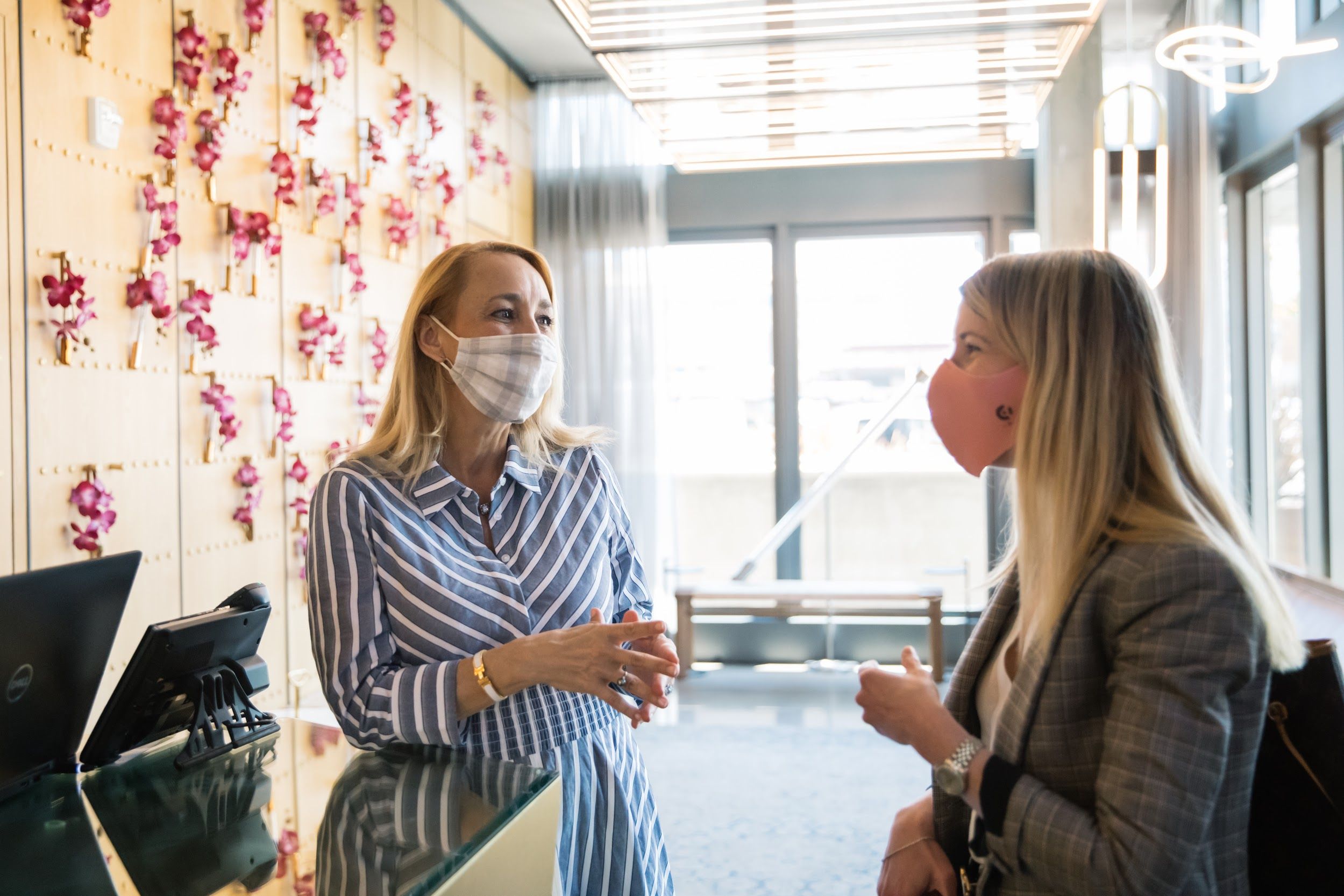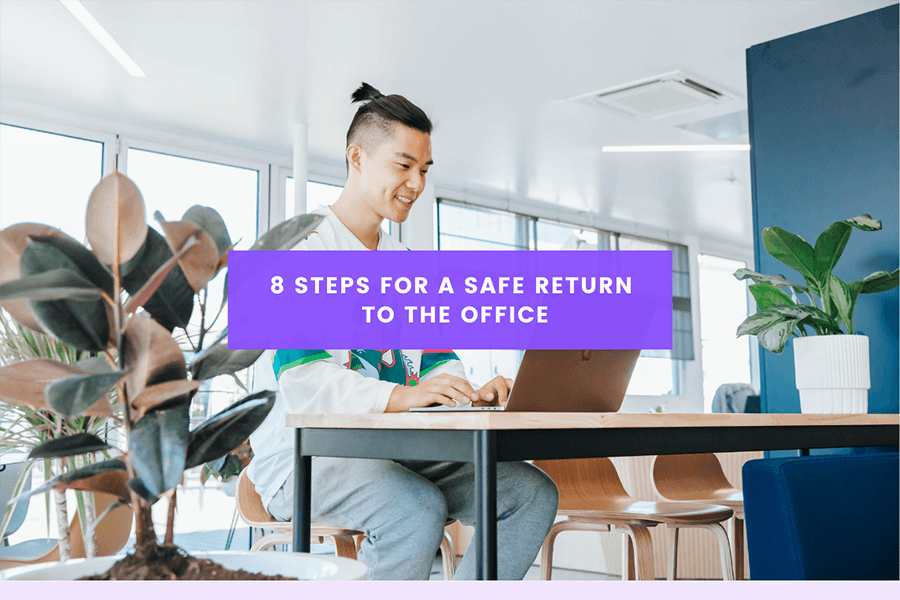April 13, 2021 by Andrea Rajic
8 Steps For A Safe Return To The Office
Table of contents
Companies across the world are gearing up and organizing their back-to-work strategies. Some have gone fully remote, others plan to move forward with hybrid work arrangements, and some even plan to go back to the office in total capacity.
For those who choose the hybrid workplace or the office, it’s critical to ensure a safe and risk-free comeback for their employees. We made a short guide with some tips on how you can implement a safe workplace return:
Workplace safety strategy
Before you start building the strategy for a safe return to work, there are some essential steps to guarantee you are going in the right direction.
Rules and regulations
As the Covid-19 pandemic is still ongoing, you should adhere to all relevant recommendations from the government, the CDC, and other relevant institutions. Implementing social distancing, mandatory masks in indoor spaces, and any other recommendations is the first step to take.
Monitor the health situation
Don’t let your information get outdated: as tiring as it may be, keep tabs on new developments, updated information, and the latest news on workplace safety and pandemic measures. We know nobody wants to listen about this topic even more, yet this is the only way to stay in the loop and provide guidance to your employees.
Prioritize employee health & safety
Every company, manager, and HR team’s goal is to facilitate a safe return to work while doing their part to minimize the risks and ease the employees’ fears about going back to the workplace. Your starting point should always be the health and safety of your workforce, and you need to communicate that effectively and clearly.
Create a plan for a safe return to work
Creating a safety plan should stem from the available information and recommendations we mentioned above. Employers need to consider all the specific factors of their company: the size of the workforce, the layouts and structures of their workspaces, and the tasks employees work on while on site.
Before you create a safety plan, make sure to take the pulse of your employees. We recently made a Return to Workplace Survey Template, with questions you can use to get feedback from your employees and see how they feel about returning to the office. Scrutinize your safety plan heavily by giving it to various departments to revise and check. Identifying gaps in your safety response and eliminating them is critical for successful strategy implementation.

Establish transparent communication and updates
As this comeback process is likely to take a while, don’t wait for a finalized strategy to update employees. The pandemic has put an unusually high stress load on all of us, your employees included. A recent report by McKinsey noted the importance of transparency and how it affects employees in the pandemic.
Companies that communicated plans transparently saw increased wellbeing and productivity in employees, while those that didn’t saw anxiety and stress rise in the workforce. Easing the employees’ concerns over health, safety, and future plans is not a step you want to leave for later. Provide timely updates every step of the way, communicate visions and questions, and listen to employee feedback.
Lower the occupancy of your spaces
We surely won’t be going back to overcrowded spaces of any kind for the foreseeable future, and offices are no exception. Start your going-back-to-work plan by limiting the number of people that can work from each indoor space. You can approach this step by determining the people who should start spending time on-site first, based on their individual roles and responsibilities.
Additionally, don’t make it mandatory for anyone to come and work on-premises. Many people are still skeptical about going back to normalcy, and it’s perfectly expected. Offer your employees support and guidance in any case, whether they work remotely or from the office.

Signage to encourage measures
As an employer, it’s your responsibility to provide guidelines, promote safe behavior, and reduce any risks to your employees’ health and well-being. As we can all drift off in our thoughts (or hundreds of emails!), make sure to create signage that reminds everyone on-site about the measures in place.
These resources can vary from hand washing instructions and barriers to specific spaces to signage that reminds people to put on masks and keep their 6-feet distance. Display these signs prominently and make them visible. A friendly nudge can go a long way in promoting positive behavior.
Flexible, hybrid, and remote work policies
For many companies and employees out there, going back to work will not mean going back to the way things were before. After a year of a forced work-from-home experiment, instead of dreading another day outside of the office, employees dread going back to the same old ways.
Even the drastic, pandemic version of remote work seems to fit everyone better: employees enjoy better use of their day, more time with friends and family, and time to recharge when they please. Employers, on the other hand, enjoy increased productivity and a happier workforce. Safety-wise, remote work is the obvious choice.
Adopting remote and hybrid work may just be the best solution for a considerable amount of companies worldwide, and many have already started the transition. The shift to flexible work is done best when companies adopt comprehensive, clear, and informative remote work policies. These documents cover every aspect of remote and on-site work and guide employees through necessary changes, protocols, and procedures to ensure maximum efficiency and compliance on all sides.
Provide access to flexible short-term offices
As the modern workplace is changing and evolving, we’re seeing the rise of third spaces - places that are neither a home nor an office, where people go to work and socialize, depending on their needs.
These short-term offices can be beneficial for every company with a flexible or fully remote workforce, as they provide a place to meet, collaborate, and work together without the need for an expensive office or HQ location. Employees are happier, more productive, and less prone to burnout, while companies can show their commitment to wellbeing and productivity simultaneously.

Embrace workplace visibility & analytics
Finally, companies can (and should) turn to software and technology that enable them to track and analyze their workplace. In these circumstances, it’s essential to know how the workspaces are being used, by how many people, how often, and which spaces employees use most. Through this tech, you can implement health statements, safety protocols, and occupancy limitations as well as manage a safe and risk-free workplace.
Even when the pandemic is over, companies that switched to hybrid and remote work will need to know the employees’ needs regarding physical workspaces and provide them with the best possible options. Using software to gain actionable insight is an excellent step towards a more efficient workplace.
Meet your team where they are
Manage your workplace strategy easily, with a centralized platform for booking, management, and insights.
Andrea Rajic
SHARE
